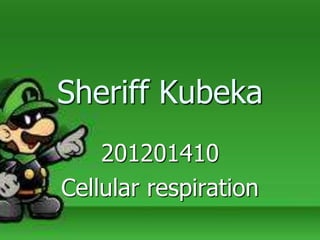
Sheriff kubeka
- 2. Cellular Respiration When we eat, we get energy (glucose and other sugars) Food energy is broken down into usable energy Energy used to bond phosphate groups to ADP to make ATP
- 3. Cellular Respiration What is cell respiration??? Respiration: the process of breaking down food molecules into usable energy THE GOAL: Create ATP for cells to use Free up electrons—have high energy
- 6. Cellular Respiration Types of cell respiration Aerobic Processes: REQUIRE oxygen to take place A lot of energy available (efficient) Anaerobic Processes: DO NOT require oxygen to take place Get energy quickly (inefficient)
- 7. Glycolysis Involves breaking down 6-carbon sugars Break sugars into pyruvic acid molecules 3-Carbon molecules This process is ANAEROBIC No oxygen necessary Occurs in the cytoplasm of cells
- 8. Glycolysis You will need to know this…
- 10. Glycolysis Glycolysis also creates hydrogen ions and free electrons The whole point of respiration = high energy H + ions bond with NAD+ to form NADH + H + NADH carries electrons and H + ions This process uses 2ATP molecules and creates 4 ATP molecules
- 12. Glycolysis TOTAL ATP PRODUCTION: Glycolysis Step 1 uses 2 ATP molecules Glycolysis Step 2 converts 4 ADP molecules into 4 ATP molecules Net ATP production = 2 ATP for every glucose molecule
- 13. Glycolysis
- 14. Glycolysis Oxygen is our friend… When oxygen is present, aerobic respiration occurs Happens in the mitochondria
- 15. Glycolysis Breaking down Pyruvic Acid… Occurs in the mitochondria Pyruvic Acid = 3-carbon compound Broken down into… 2-Carbon compound—acetic acid Carbon Dioxide
- 16. Glycolysis Intermediate Step in Glycolysis 2-Carbon Compound—Acetic Acid Combined with coenzyme A (CoA) Forms compound called acetyl-CoA This is only an intermediate step—have to move pyruvic acid into Krebs Cycle
- 18. Citric Acid (Krebs) Cycle Produces more ATP and releases more electrons Electrons picked up by NAD + and FAD Organic carrier molecules Occurs inside mitochondria Mitochondrial Matrix
- 19. Citric Acid (Krebs) Cycle Acetyl CoA combines with a 4-carbon molecule to form a 6-carbon molecule Citric Acid Citric Acid broken down into a 5-carbon compound NAD + removes electrons (NADH + H +) CO2 released
- 21. Citric Acid (Krebs) Cycle 5-carbon compound broken down into a 4-carbon compound ATP created NAD + removes electrons (NADH + H +) CO2 released 4-carbon compound (oxaloacetic acid) is created Used to bond with acetyl- CoA to restart cycle
- 23. Citric Acid (Krebs) Cycle
- 24. Citric Acid Cycle = 2 ATP Cellular respiration
- 25. Electron Transport Chain What is the ETC??? A series of molecules along which electrons are transferred, releasing energy Occurs in the mitochondria— wall of mitochondria Aerobic process Oxygen is involved Acts as the electron acceptor
- 26. Electron Transport Chain As the electrons are passed between carrier proteins, energy is released ATP is created Electrons are given up by the carrier molecules NADH and FADH2 ------- NAD + and FAD
- 28. Electron Transport Chain As the electrons (H + ions) travel down the chain, they bond with oxygen 2 H + + 1 O = water (H2O) Electron acceptor Carbon is given off as carbon dioxide
- 31. Electron Transport Chain A problem exists if there is no oxygen Anaerobic process When oxygen is used up, electrons cannot be removed Traffic jam in the mitochondria KEY POINT —Electron Transport Chain cannot run without oxygen
- 32. Anaerobic Respiration If no oxygen present after glycolysis, pyruvic acid can still be broken down Fermentation 2 ATP made during fermentation Uses electrons carried by NADH + H + so that NAD+ can regenerate for glycolysis
- 33. Anaerobic Respiration Two types of fermentation Lactic Acid Fermentation Alcoholic Fermentation Glucose 2 Pyruvic Acid 2 Lactic Acid Glucose 2 Pyruvic Acid 2 Ethanol + 2 CO2
- 34. Anaerobic Respiration Lactic Acid Fermentation NADH produce during glycolysis transfers H atoms to pyruvate reducing it to lactate. Muscle fatigue When your muscle cells require more energy than can be produced Lack of oxygen Lactic acid build up = muscle fatigue When oxygen is present, lactic acid breaks down
- 37. Anaerobic Respiration Alcohol Fermentation Occurs in bacteria, plants and most animals Can you think of a bacteria that is used for fermentation??? Pyruvic Acid is converted into ethanol and carbon dioxide
- 38. Dacrboxylate pyruvate , releasing CO2 and forming 2-C compound called acetaldehyde. NADH produced during glycolysis transfers hydrogen atoms to acetaldehyde, reducing it to ethyl alcohol. Basis for the production of beer, wine, and other alcoholic beverages.
- 39. Electron Transport chain Occurs in the inner membrane of the mitochondrion. Energized electrons are carried by NADH and FADH2 to the top of the chain. The electrons are passed from protein to protein within the membrane, slowly releasing their energy in steps. Some of that energy is used directly to form ATP.
- 41. Cellular Respiration General Formula C6H12O6 + 6 O2 6 CO2 + 6 H2O
- 42. Reference list o Durana. Y . (2011) . Cellular respiration. http://www.slideshare.net/yang286/cellula r-respiration-9394052
